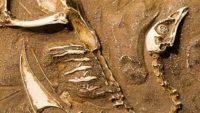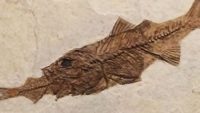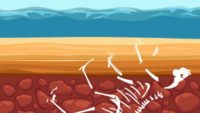By Ken Ham Euthanasia is the idea that a patient can choose to end their own life, with a doctor’s help. Belgium now allows children of any age to choose euthanasia. …read more Source: AIG Daily
By Ken Ham Our Eden Animal Experience at the Creation Museum has been a huge hit with guests. Visitors enjoy interacting with our camels, zorse and zonkey, Zebu steers, wallabies, goats, sheep, and other creatures. Our zookeepers do a great job caring for the animals, and part of that care involves animal enrichment activities. These activities encourage the animals to remain active while practicing natural behaviors. And you can help create some of the items used during these enrichment activities! On Saturdays, now through September 8, we’re offering a Let’s Build Animal Enrichment! workshop that allows you, or your child, [More]
By Dr. Ross Anderson While design may be seen in all living creatures, the early development of the fruit fly shows the making of a “simple” fruit fly exhibits forethought. …read more Source: AIG Daily
By Sylvia Thornburg Are you a grandparent or hope to be one someday? No matter where you are in life there are children who would be blessed by your prayers. …read more Source: AIG Daily
How to reach out to ‘Alien’ experiencers. …read more Source: creation.com
Sneak peek of latest Creation magazine. Some have speculated that the idea of atlatl-assisted spearthrowing came from watching herons hunt. …read more Source: <a href=http://creation.com/atlatl-heron-neck target=_blank title="The atlatl (woomera) and the heron's neck” >creation.com
By Ken Ham It’s hard to believe we’ve already celebrated the second anniversary of the Ark Encounter! Visitors continue to pour in from all around the world to see the full-size Noah’s Ark, which is having These videos are featured on the leading faith and family video streaming service PureFlix.com. In our new agreement with them, even more people will see our excellent content. Eventually all of our videos (that’s more than 500 videos!) will be featured on the Answers in Genesis channel on PureFlix.com at no additional cost to subscribers. Free One-Month Trial For the …read more Source: Ken [More]
Australopiths are in the news again. …read more Source: creation.com
The Sahara Desert was once well-watered. How did it become a desert?
Opening today, a unique cinema-graphic experience awaits Creation Museum guests with the 3D film In Six Days, shown in The 4D Special Effects Theater. …read more Source: AIG Daily
By Sarah Chaffee On this episode of ID the Future, historian Michael Flannery discusses his just-released book Nature’s Prophet: Alfred Russel Wallace and His Evolution from Natural Selection to Natural Theology. It’s the intellectual history of Wallace, who is credited with independently propounding the the theory of evolution by natural selection. Darwin insisted on a purely materialistic version of the theory, but as Wallace studied the evidence, he grew convinced that intelligent design also played a role in the history of life, particularly in the origin of humans. Though not a religious person, he broke with the rising scientism of [More]
By Ken Ham Tour most museums or open almost all geology textbooks, and you’ll see fossils presented through one lens: they were deposited slowly and gradually over millions of years. But there’s an entirely different way of looking at fossils that actually explains what we observe—the global flood of Noah’s day. In a biblical worldview, fossils are not the result of millions of years of slow and gradual processes. Most were rapidly buried during the yearlong flood. This rapid, catastrophic burial explains the geological features we see: Preservation of soft parts and creatures like jellyfish that have no hard parts. [More]
By Ken Ham We’re excited to announce we shattered an attendance record at the Ark Encounter last weekend. On Saturday, August 4, 2018, we welcomed over 8,500 paying guests to the full-size Noah’s Ark in Northern Kentucky. The actual number on Saturday was even higher: countless young children and Ark members (and their guests) enter without paying and they don’t show up in the 8,500 figure. As families travel for their end-of-summer vacations, they continue to pour into the area in huge numbers to see both Ark Encounter and the Creation Museum. This same weekend, between the two attractions, we [More]
After nearly sixty years of misinterpreting these bones from ‘human prehistory’, how could paleontologists have gotten it so wrong? …read more Source: creation.com
By Ken Ham When you hear about fossils, it’s generally within the context of hundreds of thousands or millions of years. Indeed, a recent news article on lab-made fossils began with “fossils are certainly fascinating, but [they] do take rather a long time to form.” It later adds, “over the course of anywhere from tens of thousands to millions of years…the bones [turn] to stone.” But what did the lab-made fossils really demonstrate? They showed it doesn’t take millions of years to form fossils! Scientists were able to make fossils from fresh specimens in just 24 hours—one day! All it [More]
By Ken Ham We are serious about protecting and organizing the Answers in Genesis ministry for the future. …read more Source: AIG Daily
By Sarah Chaffee On this episode of ID the Future, author and professor Nancy Pearcey draws on her new book Love Thy Body: Answering Hard Questions About Life and Sexuality to explore two inconsistencies she sees with philosophical materialists. One inconsistency is their unlivable claim that “we have no free will.” The other is the materialist credo to take our cues from nature — except when it comes to the male or female sexual makeup of one’s body. Please consider donating to support the IDTF Podcast. Your browser does not support playing Audio, please upgrade your browser or find our
A tragic fruit of the evolutionary compromise in today’s evangelical churches is the resurrection of age-old heresy concerning the deity of Jesus Christ. …read more Source: creation.com
In the U.S. Gulf Coast region, the Upper Jurassic Norphlet Sandstone rests right on top of thousands of feet of Middle Jurassic salt, known as the Louann Salt. Secular geologists believe this sandstone layer was deposited by the windblown accumulation of sand in an arid environment. These kinds of deposits are commonly called aeolian deposits.1 Secular scientists never address or explain exactly how this cl… More… …read more Source: icr.org
By Ken Ham We’ve been thrilled to partner with the Wild family over the past several years. The Wilds are a missionary family with four boys who are serving an unreached people group in southeast Asia (Papua, Indonesia). The Wild brothers have produced, in partnership with Answers in Genesis, an excellent Christian reality series showing what life is like as missionaries in a remote corner of God’s creation. And we’re excited to announce that the Wild Brothers are back with new videos. Since their last video came out in 2016, several things have changed for the Wilds, most notably, a [More]
By Sarah Chaffee On this episode of ID the Future, Casey Luskin talks with Dr. Cornelius Hunter—a Discovery Institute Fellow, adjunct professor, and author—about his website Darwin’s Predictions, which critically examines 22 fundamental predictions of evolutionary theory. In this third podcast of the series, Dr. Hunter discusses how mutations are adaptive and features of James Shapiro’s natural genetic engineering model. Your browser does not support playing Audio, please upgrade your browser or find our podcast on podOmatic Download Episode …read more Source: id the future
By Avery Foley If there really was a global flood as described in Genesis, what would we expect to see today? Where are all the fossils of pre-flood humans? …read more Source: AIG Daily
By Ken Ham If you’ve visited the Creation Museum recently and strolled through our zoo, Eden Animal Experience, you probably noticed a small pen inside the bigger wallaby pen. This pen is the current home of Boomer, our baby Bennett’s wallaby. He’s getting used to the wallaby pen and his new buddy, Skippy, before he moves in completely. Boomer has been very popular with our guests—and it’s easy to see why: he’s adorable! Given that I’m Australian—that’s where wallabies come from in our present …read more Source: Ken Ham AIG
By Dr. Tommy Mitchell Your body produces toxic chemicals all day every day. Not to worry. Your liver’s got it covered. …read more Source: AIG Daily
In the last few years, ICR has released numerous resources to help parents teach their children creation truth. Our Guide to… series is perfect for homeschoolers or anyone who wants a detailed, easily understood science resource. Science for Kids books contain kid-friendly, hand-painted illustr… More… …read more Source: icr.org
Coffee has nutritional benefits! Scientists in Duesseldorf, Germany, report, Caffeine consumption has been associated with lower risks for multiple diseases, including type II diabetes, heart disease, and stroke…1 Coffee has nutritional benefit… More… …read more Source: icr.org
Wikipedia is shown to have major problems with biased articles, and is systematically discriminating against biblical creation.









































